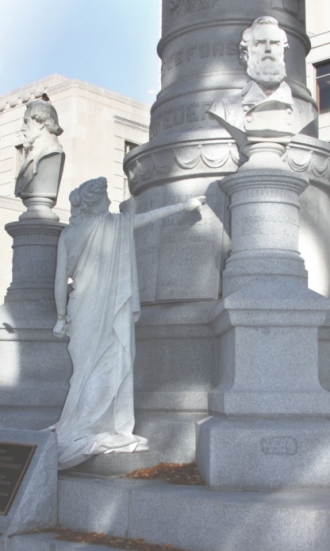MONUMENT SENDS CHILLING MESSAGE

I love American culture, I study American culture, and I cherish monuments, symbols and places that celebrate our past. A poignant moment in my past was walking through Hollywood Cemetery in Richmond, Va., visiting the grave sites of James Madison and John Marshall, and the monument to the Confederate war dead. So, I have been watching with interest the arguments on both sides of the Caddo Parish Courthouse monument issue. In my opinion, the arguments to sustain the presence of the Confederate heroes hold considerable weaknesses.
 First, it has been asserted that somehow the statues should remain due to their “educational value,” much like we shouldn’t remove “Huckleberry Finn” from our public schools. In the words of Shreveport Rep. Thomas Carmody, we should not delete “these threads in the tapestry of our story.” It is a part of our culture, so these figures should be cataloged, taught and remembered.
First, it has been asserted that somehow the statues should remain due to their “educational value,” much like we shouldn’t remove “Huckleberry Finn” from our public schools. In the words of Shreveport Rep. Thomas Carmody, we should not delete “these threads in the tapestry of our story.” It is a part of our culture, so these figures should be cataloged, taught and remembered.
While I wholeheartedly agree that Twain’s work should be consumed by students, unedited, across U.S. public schools – because it is a great literary work and reflects the racism of the time – there is an important difference between Huck Finn in school and P.G.T. Beauregard in front of the courthouse. The former is an educational setting where material is presented neutrally for analysis; the latter is in front of a government building where the law is administered. It is as though the weight and the power of the state endorses these men, who lived in a time of brutality, oppression and wholesale injustice for slaves, and then, freed slaves. It sends a chilling message to blacks who enter the building today that Caddo Parish, and its courts, are deeply rooted in generations and a system where blacks could expect no real protection under the law.
Second, it is argued that significant political gains have been made, that racial equality has blossomed tremendously over the past generation, and, thus, we can move beyond these harmless statues.
Each semester in my American government course (I teach at Centenary), we pore over data suggesting the exact opposite:
• Black unemployment rates hover two to three times above white unemployment rates (steady since the civil rights era).
• Black median household income has not kept pace with white wealth; incarceration rates are eye-poppingly disproportionate.
• Even though there are more blacks in state legislatures – and, yes, there’s that one U.S. president – since Reconstruction, there have been two blacks elected governor and five to the U.S.
Senate.
There has been a steel ceiling between blacks and channels of opportunity and power.
So, to tell blacks to “get over it” and it’s just “educational” or “historical” reveals a profound insensitivity and blindness to the horrors of our past. If we truly want to honor history, the Caddo Parish statues would, indeed, be rushed to a museum. They should not stand, in all places, in front of a courthouse where profound injustice has occurred. After 1900, the law was not administered fairly, and the state played an active role in either remaining passive in the face of violence against blacks (see Cruikshank), or aggressive in incarcerating or murdering wrongly convicted blacks (see “To Kill A Mockingbird”).
If whites in Shreveport want to signal a true appreciation of history and actual change, the statues would be moved. The Constitution celebrates freedom of expression, even hateful expression, to the fullest extent. Feel free to hoist the Stars and Bars from your truck, organize a Confederate Pride Parade, or open a museum celebrating Confederate generals. But place in front of the parish courthouse a figure with a blindfold and scales. Equality under the law should be venerated, not an unequal past.
– Mark Leeper

